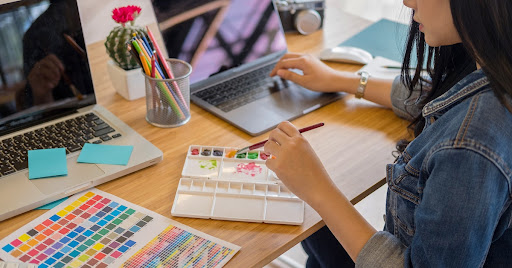
Design is not just about aesthetics; it’s about communication. Whether it’s a website, a mobile app, a product, or even a billboard, effective design can have a profound impact on how people perceive and interact with the world around them. Understanding the psychology behind design is crucial for designers to create experiences that are not only visually appealing but also meaningful and engaging. In this blog, we will explore five key aspects of the psychology behind effective design and how they can be applied to create captivating experiences.
Color Psychology
Color is a fundamental element of design that can evoke emotions, influence behavior, and shape perceptions. Different colors have distinct psychological associations and can convey specific messages. For example, warm colors like red and orange are often associated with energy and passion, while cool colors like blue and green evoke a sense of calmness and tranquility. Understanding the psychological impact of colors allows designers to strategically use them to create the desired mood or response.
Moreover, color contrast plays a crucial role in enhancing visual appeal and guiding attention. The judicious use of contrasting colors can help highlight important elements and create a hierarchy of information. By considering color psychology and employing effective color combinations, designers can evoke the desired emotional response and improve the overall user experience.
Gestalt Principles: The Power of Perception
Gestalt psychology emphasizes that humans perceive and organize visual information based on certain principles. These principles, such as proximity, similarity, closure, and figure-ground relationship, influence how we make sense of the world around us. In design, leveraging these principles can enhance the clarity and coherence of visual elements, making it easier for users to comprehend and navigate through interfaces.
For instance, the principle of proximity suggests that elements that are close together are perceived as related. By placing related elements near each other, designers can visually communicate their relationship and create a sense of unity. Similarly, the principle of closure implies that humans tend to complete incomplete shapes or patterns in their minds. Designers can utilize this principle by presenting partial information and allowing users to mentally fill in the gaps, thus engaging them in the design process.
Billboard Design to Capture Attention in Seconds
Billboards are a unique design challenge because they have limited time and space to capture attention and convey a message. With drivers passing by at high speeds, it’s crucial to create a design that is concise, impactful, and easy to comprehend at a glance. This is much more challenging than something online that a user could pause to take in for a few more moments.
In billboard design, simplicity and clarity are key. The message should be communicated with just a few words or a strong visual that can be quickly understood. Bold and contrasting colors can help the design stand out amidst the visual noise of the surrounding environment. Additionally, incorporating a strong focal point and utilizing negative space effectively can draw attention to the intended message. Since billboards are in a specific location, it also makes sense to consider the local area in your word choices and designs. You might word the same billboard differently if it’s in New York versus Maryland. For example, your Baltimore billboards should be just a little different than the ones people would see in NYC. The local landmarks are different and the ways people talk about things are distinct as well.
The Power of Simplicity
In today’s fast-paced world, people are bombarded with information from various sources. Designers must understand that users have limited cognitive resources and attention spans. To create effective designs, it is essential to minimize cognitive load and make interfaces as simple and intuitive as possible.
Reducing cognitive load involves decluttering interfaces, prioritizing essential information, and providing clear and concise instructions. By simplifying complex tasks and breaking them down into smaller, manageable steps, designers can alleviate cognitive strain and enhance usability. Additionally, utilizing familiar design patterns and leveraging users’ existing mental models can make interfaces more intuitive and reduce the learning curve.
Emotional Design
Humans are emotional beings, and our emotions heavily influence our decision-making process. Designers can tap into this aspect of human psychology by incorporating emotional design elements into their work. Emotional design focuses on creating experiences that elicit specific emotions, thus forging a connection between users and the design.
One way to achieve emotional design is through the use of visual metaphors or symbols that evoke certain emotions or associations. For example, a heart-shaped icon is commonly associated with love and affection. By utilizing such symbols, designers can tap into users’ emotional responses and create a more engaging experience. Additionally, attention to detail, personalization, and storytelling can also contribute to the emotional impact of a design.

